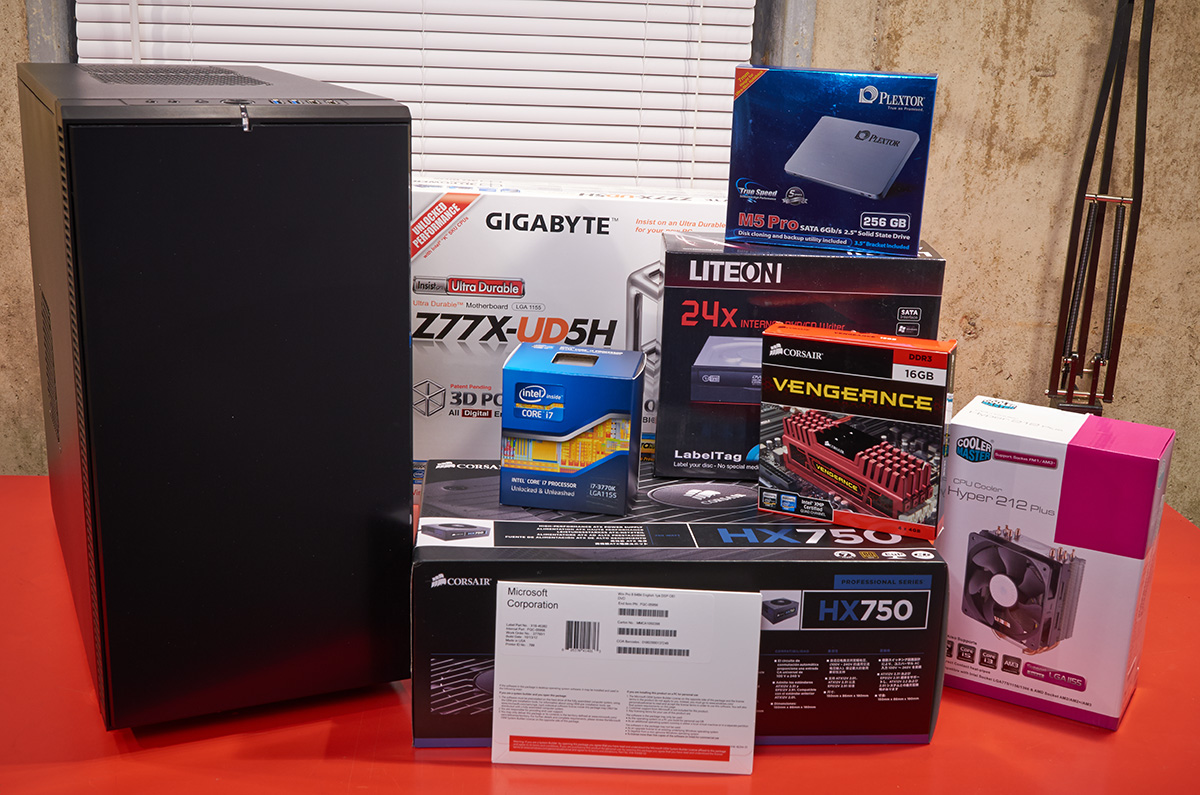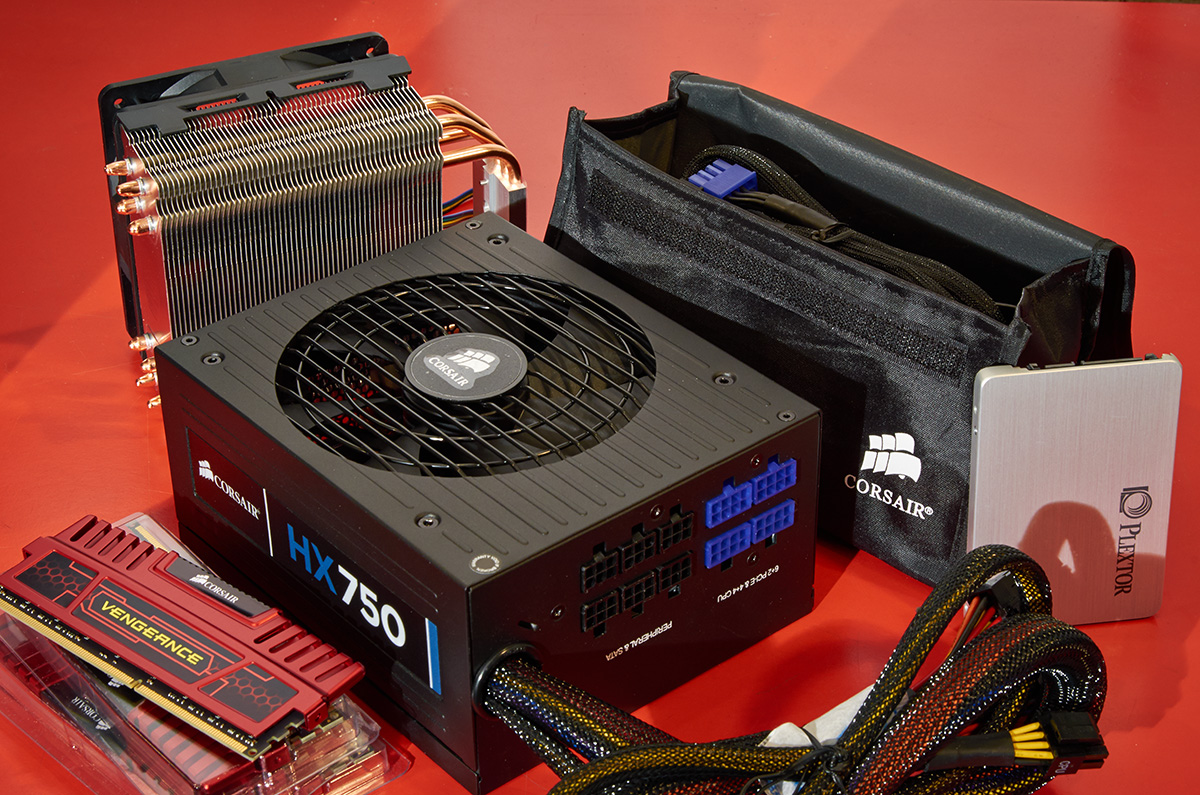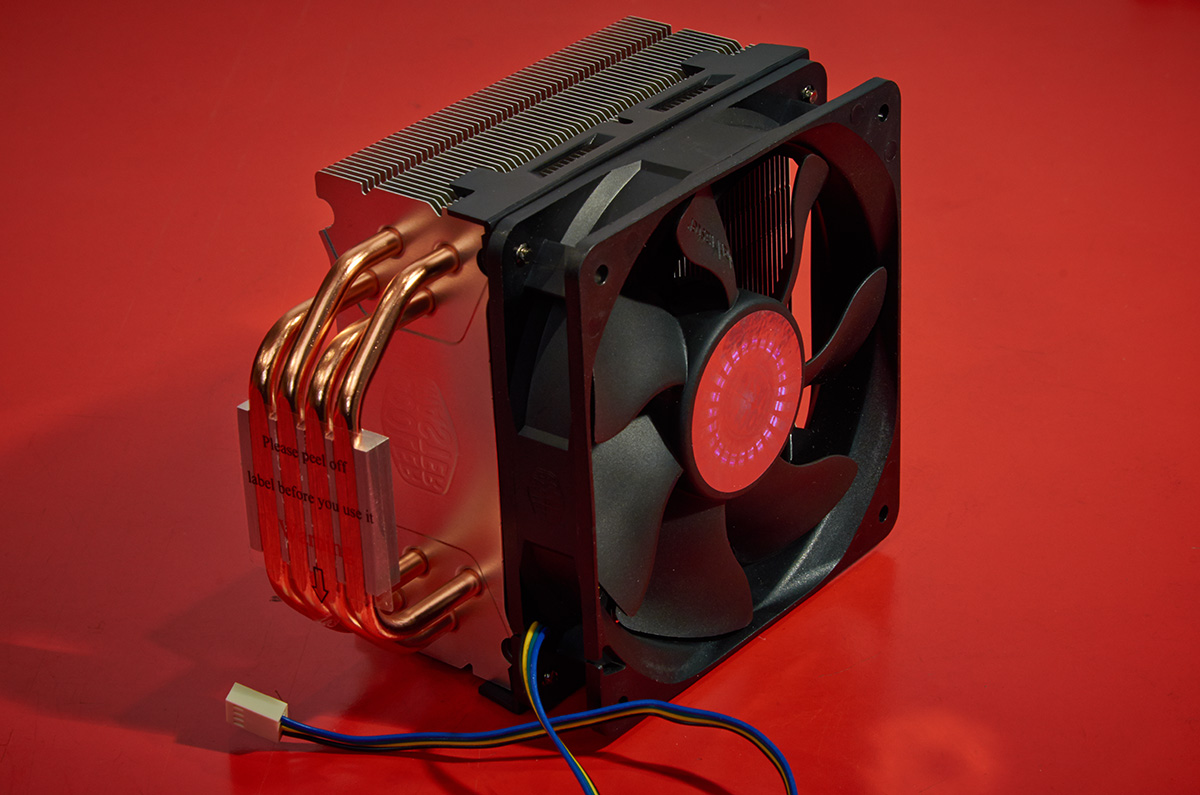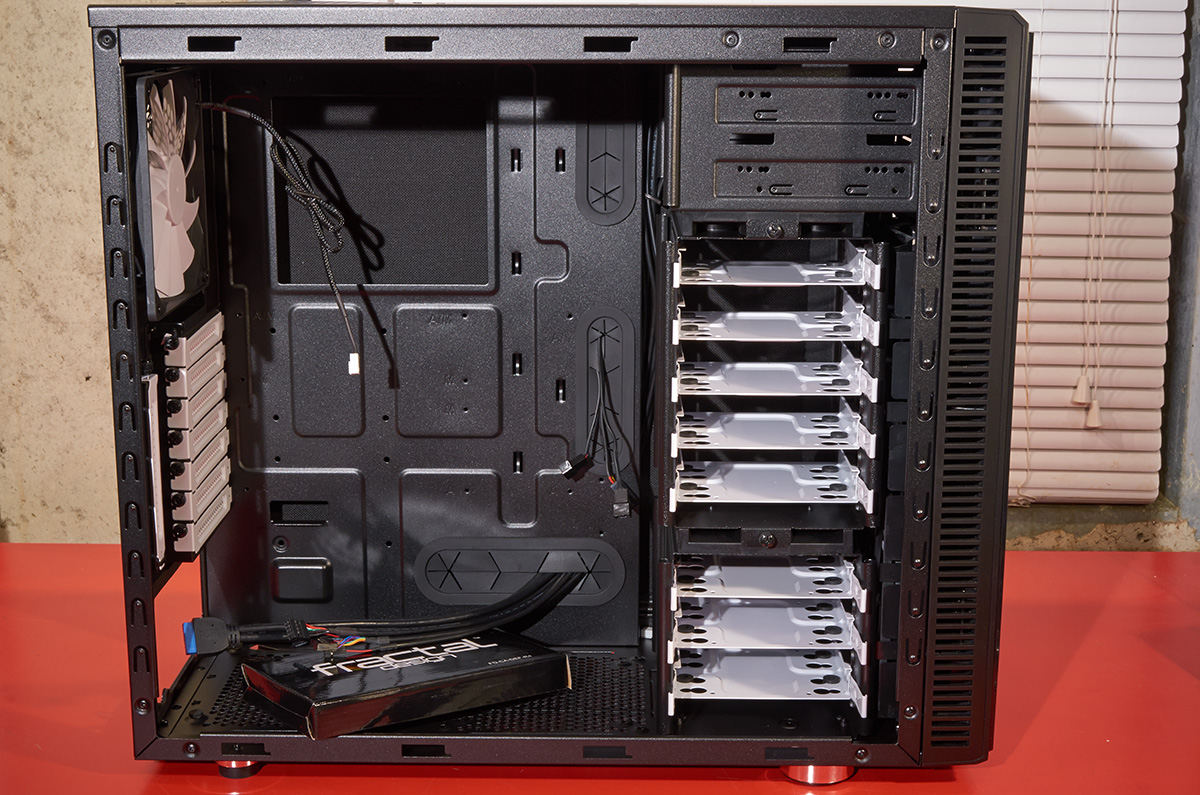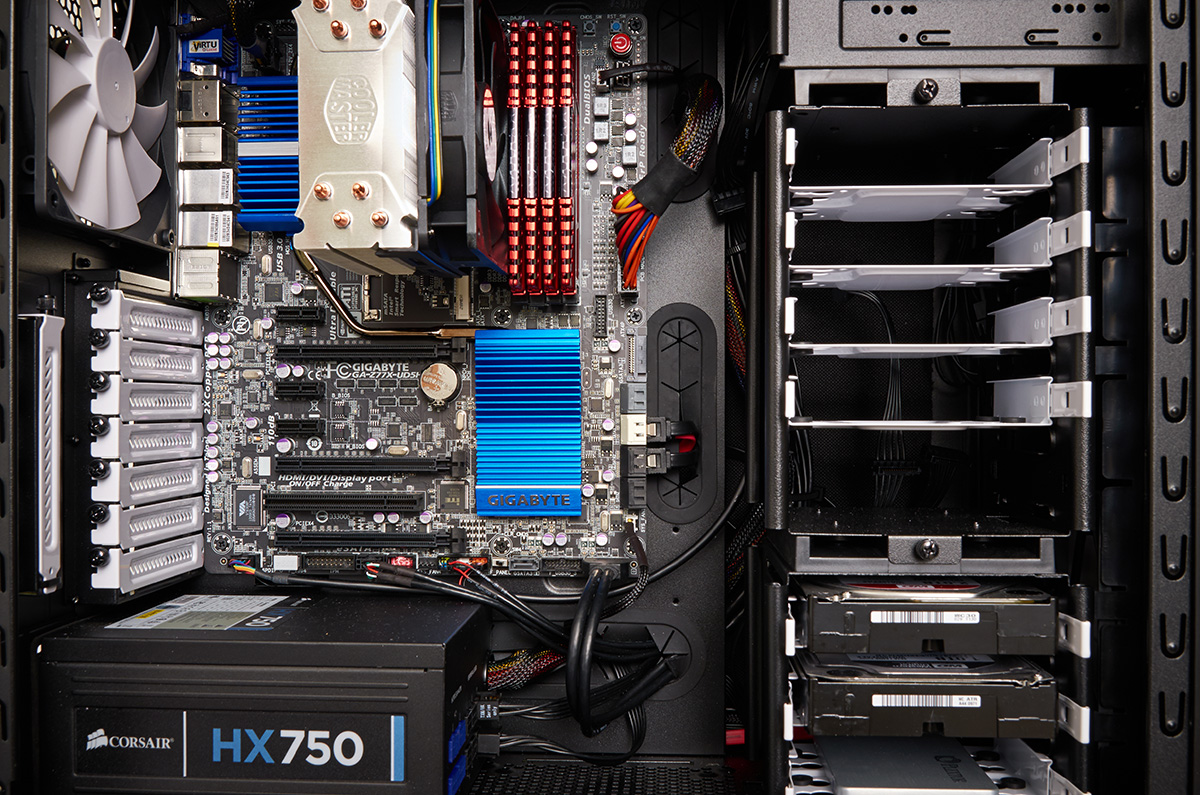Case --
The Fractal Design Define R4 Black Pearl mid-tower case
was chosen because of it's roomy interior and amenities for an easy build,
the USB 3.0 and 2.0 jacks on the top of the case,
it's orientation to quietness (with sound absorption panels) and good value.
It also has clean lines and good looks, all of which make it a popular choice.
Its a modern design with the depth necessary to accommodate large fans, and
large grommets leading to an inch of wiring space along the right panel. This
allows the wiring in the main interior to appear nearly invisible.
But all of these cases are good choices:
- Fractal Design Define R4 (selected)
- Antec P183 V3 (similar but USB Ports on the side)
- Corsair Obsidian 550D (slightly larger, higher price)
- Corsair Obsidian 650D (larger, higher price, high ratings)
- Cooler Master HAF 932 (gaming look, higher price)
Processor (CPU) --
While I considered going with 6 cores, the benefit isn't that big over 4,
and it's probably overkill for photo editing.
It's much better to put the money into a fast SSD and lots of memory, which is what I did.
Nevertheless, the i7-3770K is in the top end of the 4-core performance benchmarks while still retaining good value,
making this chip a very popular choice. Furthermore it's Intel's 3rd Generation i7 Ivy Bridge, with 22nm 3D transistor technology. One benefit is lower power (only 77 watts), helping to keep things quiet.
And the Ivy Bridge Integrated Graphics Processor (IGP) is much improved,
so we should be able get by nicely w/o a graphics card, at least initially, for most photo editing needs.
There is also considerable room for over clocking if needed/desired.
Finally, I made sure this memory is on the motherboard's supported memory list, which helps avoid any support issues should they come up.
CPU Cooling --
The Cooler Master Hiper 212+ is a very cost effective and popular upgrade over Intel-supplied fan.
The super big fan runs slowly and quietly while still moving a lot of air.
Cases are getting deeper to accommodate tall units like this.
While the case can support liquid cooling, the cost is around $100 compared to $23,
and not really needed for this application.
Memory (RAM) --
Four matched sticks of 4GB CORSAIR Vengeance DDR3 CMZ16GX3M4X2133C11R provide 16GB of RAM, which should be more than sufficient.
This is really important to performance, and memory is fairly inexpensive.
I would have gone 32GB, but adding memory beyond what can be used doesn't further improve performance.
The selected memory is rated at 2133 MHz, which lets us clock it much faster than the specs.
Power Supply --
The CORSAIR HX750 is an excellent power supply and a really nice modular unit. This means that the cables also plug into
the power supply itself rather than being hard wired. This means you only have to connect the cables you need, so you don't
end up with a big ball of cables to tie up somewhere in the case. It's actually a hybrid in that some of the cables are fixed,
but these are the ones that always plug into the motherboard, which is even better. The power supply even comes in a velvet-like case,
and the unused cables have their own pouch for storage. I chose 750 watts to allow for the addition of one high end graphics board in the future.
This should be fine even if we select the top end board in the $500 range, but it should have even higher wattage if you plan on adding two high end cards.
Motherboard --
The Gigabyte GA-Z77X-UD5H Motherboard is a high performance board offering plenty of ports and expandability with good value.
Another good choice would be the Asus (e.g., P8Z77-V Pro or Delux at higher cost). While the Asus is favored by over clocker's,
the Gigabyte will do a fine job there as well, and I've had very good luck with the Gigabyte.
The selected board doesn't have a lot of frills like WiFi and Blue Tooth, but these can be added as needed.
Solid State Drive --
There is a lot of discussion/debate about SSD reliability, with many reported failures by customers in the review areas.
Right now it doesn't seem to be clear whether reliability is better or worse than hard drives.
I chose the Plextor PX-256M5P because its "thought" to be one of the higher reliability solutions,
and it comes with a 5 year warranty (I don't normally pay attention to warrantees, but made an exception here).
It's also very fast both reading and writing. Of course I'm planning on backing up often, but that should be done anyway.
An SSD makes a significant difference in performance, so I think it's worth it.
Hard Drive --
Here the Western Digital Black is considered to be s solid performance and reliability solution these days.
I just needed 1 Terabyte for now
but a couple of 2 Terabyte drives would go a lot further.
Operating System --
I selected the professional version only because I may need to run virtual OS's like Linux in the future. The regular version would normally be just fine.
While Windows 8 should be better than 7, it's getting mixed reviews for its interface so that should be a consideration.
Optical Drive
This can be anything from Blue Ray to nothing -- I just picked one of the available standard time-proven (and cheap) LITE-ON units simply
for the convenience of having a DVD reader/burner. But do get one with a SATA interface to avoid wrestling with the bigger legacy cable.
Graphics Card --
No graphics card yet.
But I'd consider the NVIDEA chips, where the GTX 680 is at the top end right now, the GTX 670 is the next level down,
being a good value with nearly the same performance.
Next would be the GTX 660, a good mid/high solution in the $300 range. EVGA seems to have good reviews as the board maker,
so I'm considering something like the
EVGA 02G-P4-3660-KR GeForce GTX 660 Ti 2GB 192-bit GDDR5 PCI Express 3.0 x16 HDCP Ready SLI Support Video Card
Results --
So how does it work? It's fast -- I mean really really fast.
The SSD helps a lot for regular operations like booting, bringing up Photoshop, and file copying.
And I haven't over clocked anything yet.
It's fine so far w/o the graphics card but some of the sliders on PhaseOne Capture One Pro 7 would
probably be much smoother with the card, since they do use the graphics engine.
But there isn't enough delay to make it annoying, so it seems fine for now. It's also pretty quiet.
You wouldn't know it was on in an office environment.
At home you can definitely hear it but it's at a very low level and at a lower pitch due to the slower moving fans.
That tunes out pretty quickly.
| 